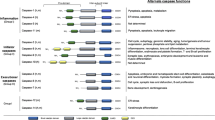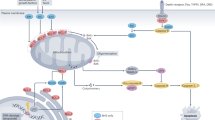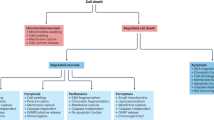Abstract
Caspases are the key effector molecules of the physiological death process known as apoptosis, although some are involved in activation of cytokines, rather than cell death. They exist in most of our cells as inactive precursors (zymogens) that kill the cell once activated. Caspases can be controlled in two ways. The processing and activation of a caspase can be regulated by molecules such as FADD, APAF-1, Bcl-2 family members, FLIP and IAPs. Active caspases can be controlled by a variety of inhibitors that directly interact with the protease. This review describes the later direct caspase inhibitors that have been identified, products of both viral and cellular genes, and artificial caspase inhibitors that have been developed both as research tools and as pharmaceutical agents to inhibit cell death in vivo.
Similar content being viewed by others
Article PDF
Author information
Authors and Affiliations
Corresponding author
Additional information
Edited by G Melino
Rights and permissions
About this article
Cite this article
Ekert, P., Silke, J. & Vaux, D. Caspase inhibitors. Cell Death Differ 6, 1081–1086 (1999). https://doi.org/10.1038/sj.cdd.4400594
Received:
Revised:
Accepted:
Published:
Issue Date:
DOI: https://doi.org/10.1038/sj.cdd.4400594
Keywords
This article is cited by
-
Virulence-related gene wx2 of Toxoplasma gondii regulated host immune response via classic pyroptosis pathway
Parasites & Vectors (2022)
-
Gasdermin E-derived caspase-3 inhibitors effectively protect mice from acute hepatic failure
Acta Pharmacologica Sinica (2021)
-
One-Pot Radiosynthesis and Biological Evaluation of a Caspase-3 Selective 5-[123,125I]iodo-1,2,3-triazole derived Isatin SPECT Tracer
Scientific Reports (2019)
-
Novel association between apoptotic sperm biomarkers with seminal biochemical parameters and acetylcholinesterase activity in patients with teratozoospermia
Journal of Assisted Reproduction and Genetics (2019)
-
Bile acids at neutral and acidic pH induce apoptosis and gene cleavages in nasopharyngeal epithelial cells: implications in chromosome rearrangement
BMC Cancer (2018)



